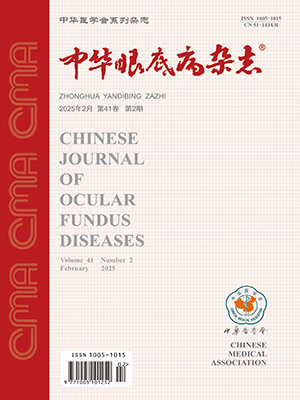| 1. |
谢若天, 颜华. 表观遗传学在糖尿病视网膜病变中的研究进展[J]. 中华眼底病杂志, 2020, 36(8): 657-660. DOI: 10.3760/cma.j.cn511434-20190213-00045.Xie RT, Yan H. Epigenetic research progression in diabetic retinopathy[J]. Chin J Ocul Fundus Dis, 2020, 36(8): 657-660. DOI: 10.3760/cma.j.cn511434-20190213-00045.
|
| 2. |
刘玉华, 高玲. 糖尿病视网膜病变治疗研究现状、问题与展望[J]. 中华眼底病杂志, 2016, 32(2): 206-210. DOI: 10.3760/cma.j.issn.1005-1015.2016.02.024.Liu YH, Gao L. The status, problem and progress of diabetic retinopathy treatment[J]. Chin J Ocul Fundus Dis, 2016, 32(2): 206-210. DOI: 10.3760/cma.j.issn.1005-1015.2016.02.024.
|
| 3. |
李筱荣. 糖尿病视网膜病变基础研究的热点和难点[J]. 中华眼底病杂志, 2007, 23(4): 234-237.Li XR. Hotspots and problems of basic research for diabetic retinopathyt[J]. Chin J Ocul Fundus Dis, 2007, 23(4): 234-237.
|
| 4. |
MacCarthy P, Peterson MJ, Malcolm RL, et al. Separation of humic substances by pH gradient desorption from a hydrophobic resin[J]. Analytical Chemistry, 1979, 51(12): 2041-2043. DOI: 10.1021/ac50048a036.
|
| 5. |
Naudé PJ, Cromarty AD, van Rensburg CE. Potassium humate inhibits carrageenan induced paw oedema and a graft-vs-host reaction in rats[J]. Inflammopharmacology, 2010, 18(1): 33-39. DOI: 10.1007/s10787-009-0026-8.
|
| 6. |
Motojima H, Villareal MO, Han J, et al. Microarray analysis of immediate-type allergy in KU812 cells in response to fulvic acid[J]. Cytotechnology, 2011, 63(2): 181-190. DOI: 10.1007/s10616-010-9333-6.
|
| 7. |
Chien SJ, Chen TC, Kuo HC, et al. Fulvic acid attenuates homocysteine-induced cyclooxygenase-2 expression in human monocytes[J/OL]. BMC Complement Altern Med, 2015, 15: 61[2015-03-13]. https://pubmed.ncbi.nlm.nih.gov/25888188/. DOI: 10.1186/s12906-015-0583-x.
|
| 8. |
Sherry L, Millhouse E, Lappin DF, et al. Investigating the biological properties of carbohydrate derived fulvic acid (CHD-FA) as a potential novel therapy for the management of oral biofilm infections[J/OL]. BMC Oral Health, 2013, 13: 47[2013-09-24]. https://pubmed.ncbi.nlm.nih.gov/24063298/. DOI: 10.1186/1472-6831-13-47.
|
| 9. |
Wershaw RL, Pinckney DJ, Booker SE. Chemical structure of humic acids-part 1, a generalized structural model[J]. Journal of Research of the US Geological Survey, 1977, 5(5): 565-569.
|
| 10. |
Lehmann J, Kleber M. The contentious nature of soil organic matter[J]. Nature, 2015, 528(7580): 60-68. DOI: 10.1038/nature16069.
|
| 11. |
Yin J, Xia W, Li Y, et al. COX-2 mediates PM2.5-induced apoptosis and inflammation in vascular endothelial cells[J]. Am J Transl Res, 2017, 9(9): 3967-3976.
|
| 12. |
张哲, 刘巨平, 东莉洁, 等. 高糖状态下视网膜血管内皮细胞基因表达谱的RNA-Seq分析[J]. 中华眼底病杂志, 2018, 34(4): 377-381. DOI: 10.3760/cma.j.issn.1005-1015.2018.04.014.Zhang Z, Liu JP, Dong LJ, et al. RNA-Seq analysis of gene expression profiling in retinal vascular endothelial cells under high glucose condition[J]. Chin J Ocul Fundus Dis, 2018, 34(4): 377-381. DOI: 10.3760/cma.j.issn.1005-1015.2018.04.014.
|
| 13. |
Joy SS, Siddiqui K. Molecular and pathophysiological mechanisms of diabetic retinopathy in relation to adhesion molecules[J]. Curr Diabetes Rev, 2019, 15(5): 363-371. DOI: 10.2174/1573399814666181017103844.
|
| 14. |
Krol J, Loedige I, Filipowicz W. The widespread regulation of microRNA biogenesis, function and decay[J]. Nat Rev Genet, 2010, 11(9): 597-610. DOI: 10.1038/nrg2843.
|
| 15. |
Fabian MR, Sonenberg N, Filipowicz W. Regulation of mRNA translation and stability by microRNAs[J]. Annu Rev Biochem, 2010, 79: 351-379. DOI: 10.1146/annurev-biochem-060308-103103.
|
| 16. |
Gour N, Wills-Karp M. IL-4 and IL-13 signaling in allergic airway disease[J]. Cytokine, 2015, 75(1): 68-78. DOI: 10.1016/j.cyto.2015.05.014.
|
| 17. |
Kuperman DA, Schleimer RP. Interleukin-4, interleukin-13, signal transducer and activator of transcription factor 6, and allergic asthma[J]. Curr Mol Med, 2008, 8(5): 384-392. DOI: 10.2174/156652408785161032.
|
| 18. |
Cerwenka A, Lanier LL. Natural killer cell memory in infection, inflammation and cancer[J]. Nat Rev Immunol, 2016, 16(2): 112-123. DOI: 10.1038/nri.2015.9.
|
| 19. |
Bigger JE, Thomas CA 3rd, Atherton SS. NK cell modulation of murine cytomegalovirus retinitis[J]. J Immunol, 1998, 160(12): 5826-5831.
|
| 20. |
Granger DN, Kubes P. The microcirculation and inflammation: modulation of leukocyte-endothelial cell adhesion[J]. J Leukoc Biol, 1994, 55(5): 662-675. DOI: 10.1002/jlb.55.5.662.
|
| 21. |
Huang WS, Yang JT, Lu CC, et al. Fulvic acid attenuates resistin-induced adhesion of HCT-116 colorectal cancer cells to endothelial cells[J]. Int J Mol Sci, 2015, 16(12): 29370-29382. DOI: 10.3390/ijms161226174.
|
| 22. |
Behl T, Kaur I, Kotwani A. Implication of oxidative stress in progression of diabetic retinopathy[J]. Surv Ophthalmol, 2016, 61(2): 187-196. DOI: 10.1016/j.survophthal.2015.06.001.
|
| 23. |
王树林, 金学民. 糖尿病鼠视网膜细胞间黏附分子-1的表达与血视网膜屏障破坏的关系及曲安奈德的治疗作用[J]. 中华眼底病杂志, 2006, 22(1): 24-27. DOI: 10.3760/j.issn:1005-1015.2006.01.007.Wang SL, Jin XM. Relationship between expression of retinal intercellular adhesion molecule-1 and blood-retinal barrier rupture and therapeutic effect of triamcinolone acetonide in diabetic rats[J]. Chin J Ocul Fundus Dis, 2006, 22(1): 24-27. DOI: 10.3760/j.issn:1005-1015.2006.01.007.
|




